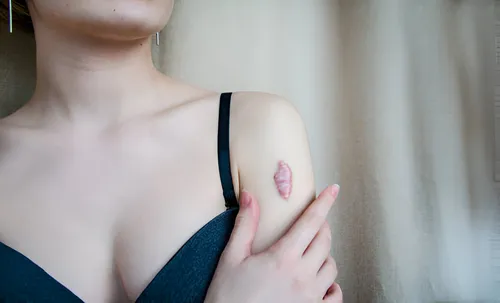Keloid scars present a significant challenge in dermatological treatments, characterized by excessive tissue growth beyond the original wound site. Traditional treatments have included corticosteroid injections, surgical excision, and cryotherapy, yet these methods often yield inconsistent results. Recent studies, including those reviewed in the journal Scars, Burns & Healing, suggest that botulinum toxin (commonly known as Botox) offers a promising alternative in the management of keloid scars.
What are Keloid Scars?
Keloid scars are a form of abnormal wound healing where there is an overproduction of collagen, resulting in raised, often reddish or purplish scars that extend beyond the original injury. Unlike hypertrophic scars, keloids do not regress over time and can be itchy or painful, posing both cosmetic and physical discomfort to individuals.
How Botox Works for Keloid Scars
Botulinum toxin is well-known for its cosmetic use in reducing wrinkles by paralyzing facial muscles. Its potential in scar management lies in its ability to reduce muscle tension around the scar site and modulate fibroblast activity, crucial for collagen production.
1. Reduction of Muscle Tension: Botox paralyzes muscles near the scar, decreasing the tensile forces that contribute to keloid formation. This reduction in tension can alleviate the inflammatory response and subsequent collagen overproduction.
2. Regulation of Fibroblast Activity: Studies show that Botox can inhibit the activity of fibroblasts, the cells responsible for collagen production. This is achieved through the reduction of transforming growth factor (TGF)-β1 and connective tissue growth factor (CTGF), both of which play significant roles in keloid pathogenesis.
Clinical Evidence Supporting Botox Use
Several studies have examined the efficacy of Botox in treating keloid scars:
– Shaarawy et al. conducted a randomized study with 24 female patients comparing Botox injections to intralesional corticosteroid therapy. The results indicated that Botox was as effective as steroids in reducing keloid volume, height, and redness, with significant patient satisfaction reported.
– Li et al. reviewed the use of Botox combined with betamethasone, showing a notable improvement in keloid symptoms such as itching and pain, alongside reduced scar volume.
– Zhibo et al. found that repeated Botox injections led to significant improvements in keloid appearance and patient satisfaction over a 12-month follow-up period.
Advantages of Botox in Keloid Management
1. Symptom Relief: Botox has been shown to significantly alleviate symptoms associated with keloids, such as pain and itching, which are not always addressed by traditional treatments.
2. Improved Scar Appearance: Patients receiving Botox injections often report better cosmetic outcomes, with scars appearing less raised and more pliable.
3. Safety Profile: Botox has a well-established safety profile in medical and cosmetic applications, making it a viable option for those seeking non-invasive scar treatment.
Botox represents a promising therapeutic option for managing keloid scars, offering benefits in both symptom relief and cosmetic improvement. While current evidence is encouraging, further large-scale, long-term studies are needed to fully establish its efficacy and optimal use protocols in scar management. As research progresses, Botox may become a standard part of keloid treatment regimens, providing relief and improved quality of life for patients afflicted with these challenging scars.

